Despite having a $45 million budget and being billed as a “complete streets” project, the city has proposed no safety improvements for the stretch of 24th and 23rd Avenues connecting the Montlake neighborhood to Capitol Hill and the Central District (north of Madison).
Instead, the current proposal — which project heads will present to the public in two upcoming meetings — includes four lanes, with curb lanes wider than lanes on many freeways: 14.5 feet. Wide lanes are proven to encourage speeding, a leading factor in traffic deaths and injuries. In fact, the city’s own Road Safety Summit Action Plan notes, “Reducing speeding can be accomplished by ensuring that our travel lanes are not overly wide” (page 20).
The city’s proposal is not a complete street and does not belong in any neighborhood, especially not one with so many people of various ages and abilities walking and biking.
You will have two chances coming up to hear from SDOT officials and give feedback on the project: A community meeting at 6 p.m. today (February 18) at the Miller Community Center and a project open house 5 p.m. February 26 at Thurgood Marshall Elementary.
You are needed at these meetings to speak up for walking and biking safety in Montlake, Capitol Hill, Miller Park, Madison Valley and the Central District.
Outreach about this project has been rather confusing, so I will attempt to break it down into a couple easier-to-digest sections.
Phases 1 and 2
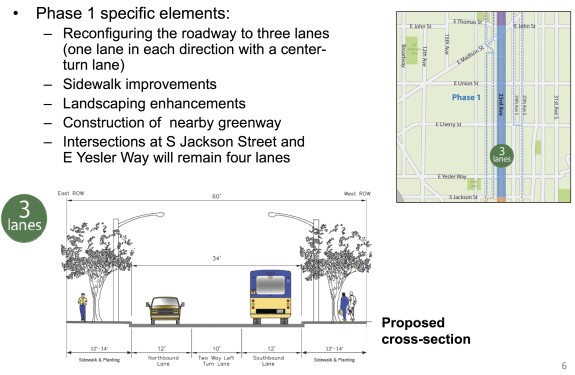 The first section of 23rd Ave to be constructed runs between E John Street and S Jackson Street. During early outreach, this was the only stretch discussed (Phases 2 and 3 were added to the project well after an open house last year, confusing people who attended that open house). This is the phase that requires the most immediate feedback, since it is approaching final design.
The first section of 23rd Ave to be constructed runs between E John Street and S Jackson Street. During early outreach, this was the only stretch discussed (Phases 2 and 3 were added to the project well after an open house last year, confusing people who attended that open house). This is the phase that requires the most immediate feedback, since it is approaching final design.
The sidewalks through this stretch are in dismal shape and are rather skinny. The road is also skinnier than other stretches of the street. So planners decided to widen and rebuild the sidewalks and convert the street to a safer three-lane configuration. While I pushed for a protected bike lane on 23rd, the planned design will increase safety and make it much more comfortable to cross this neighborhood barrier of a street.
I especially urge planners to include safety improvements for people crossing at non-signalized streets (median islands, curb bulbs, etc). Today, 23rd Ave is the neighborhood’s most dangerous street. This is the city’s chance to allow neighbors to walk across 23rd at every street, which would revolutionize walkability and bikeability in the Central District.
This is also a chance to improve transit efficiency by making sure buses stop in-lane so they are not delayed by people illegally passing as it tries to pull away from the curb (a violation so ubiquitous, it must be planned for).
The plan for Phase 2 (Jackson to Rainier) is roughly the same as Phase 1.
Phase 3
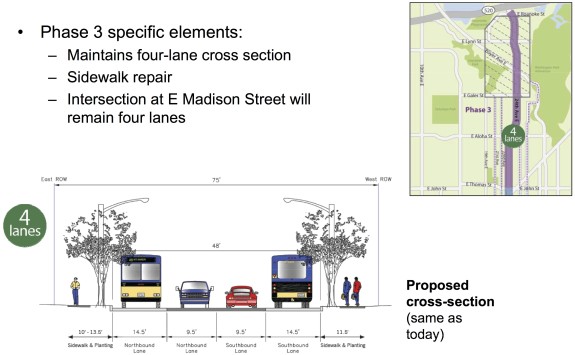 Unlike Phases 2 and 3, the city does not plan to improve safety for Phase 3 even though this northernmost segment has nearly identical daily traffic levels and has more road width than the other two phases.
Unlike Phases 2 and 3, the city does not plan to improve safety for Phase 3 even though this northernmost segment has nearly identical daily traffic levels and has more road width than the other two phases.
Essentially, Phase 3 aims to preserve the highway-like feel the road has today. Unlike with Phase 1 — where planners presented a handful of options at an open house to study the pros and cons of each option and gather community feedback — Phase 3 has had no clear community outreach process.
Phase 3 also does not appear to have gone through a complete streets analysis (which it would surely fail). A city ordinance mandates that projects receiving significant investment consider the needs of all road users.
At a recent “drop-in session” about the projects, planners included this board to explain why they planned a design change for parts of 23rd:
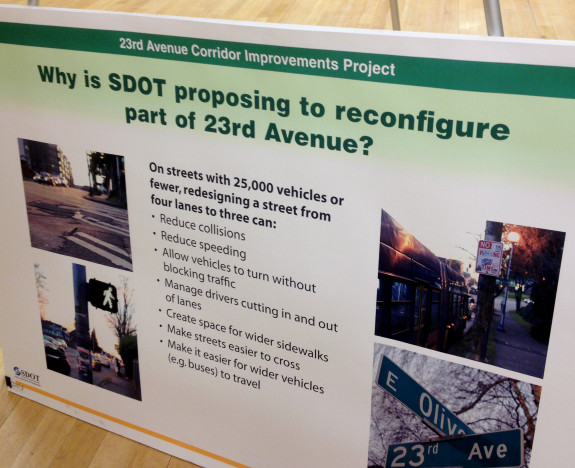 The city’s 2012 traffic counts show 24th Ave had 18,000 vehicles per day, only 500 more than 23rd Ave through the Central District and well below the 25,000 threshold where a redesign would begin to have some significant impact on traffic flow. The city’s board also lists a bunch of benefits of a safer street design: Fewer collisions, less speeding, less stressful turning, easier to cross the street, and on and on.
The city’s 2012 traffic counts show 24th Ave had 18,000 vehicles per day, only 500 more than 23rd Ave through the Central District and well below the 25,000 threshold where a redesign would begin to have some significant impact on traffic flow. The city’s board also lists a bunch of benefits of a safer street design: Fewer collisions, less speeding, less stressful turning, easier to cross the street, and on and on.
If a redesign is good for the Central District (which it is), why is it not good for Montlake, Madison Valley, Miller Park and the eastern edge of Capitol Hill?
When I asked SDOT what kind of complete streets process Phase 3 went through, they sent me an unfinished checklist that references improvements made in Phases 1 and 2 (the checklist was described as “a work in progress”). A safety improvement made in the Central District a mile up the road does not help people crossing the street in Montlake.
The good news is that Phase 3 has a long way to go, and there is time to change the design.
“While we’ve been fortunate to expand the scope to include improvements in Phase 3, it is the last phase of the project and therefore not as far advanced in both design and outreach as the other two phases,” said SDOT spokesperson Rick Sheridan in an email.
The bad news is that the city is already talking about Phase 3 as though the four-lane design is final.
“Between E Roanoke Street and E John Street (Phase 3), the road will remain four lanes,” reads a press release announcing the February 26 open house.
This is our chance to reconnect neighborhoods long split by a very dangerous and wide street. Maintaining it as a neighborhood highway is not acceptable, but people will need to speak up to change the project’s direction.
Unlike many other city projects, there is a wealth of budget and road width in Phase 3, leaving a huge number of options for safety on the table. In the city’s Road Safety Action Plan, the city made it clear that safety is the city’s top transportation priority, a desire also clearly voiced in Seattle resident surveys.
People need to speak up for the right to cross the street, and demand an end to dangerous streets in the neighborhood. Complete streets are about everyone, including people in cars. We will not accept any more senseless deaths and injuries on our neighborhood streets, big or small. Traffic can flow and be safe at the same time. We cannot wait any longer to act.
Central Area Neighborhood Greenway
The last aspect of the 23rd Ave project is the Central Area Greenway, an attempt to build a route on parallel neighborhood streets that are optimized for biking and walking. Working with Central Seattle Greenways, the city has developed some quality route options between the I-90 Trail and Miller Park.
However, extensive research, including community rides led by Central Seattle Greenways and members of the Seattle Bicycle Advisory Board (spearheaded largely by the wonderful Merlin Rainwater) have come up empty-handed in trying to find a reasonable parallel route at the north section of the project (south of the I-90 Trail could also be difficult). All options are either too steep or too circuitous to be considered a “parallel” route.
And a nearby neighborhood greenway — even if a reasonable route did exist — cannot make a street “complete.” A parallel neighborhood greenway does not reduce collisions between cars, and does not make it easier or safer to cross the street on foot or by bike.
Central Seattle Greenways has presented a preferred route for the greenway, but the group has also heard from residents upset that their side of the street will not see improvements. This is the folly of trying to build a neighborhood greenway as an alternative to making a main street safe: It only helps one half of the nearby residents. A neighborhood greenway on 25th Ave does not help someone at 21st and Yesler cross the street or get to Douglass-Truth Library. A greenway on 22nd Ave does not help someone at 24th and Madison cross the street or get to Safeway.
Between John and I-90, the planned road diet and neighborhood greenway combo seems mostly workable. But the north section will likely require an actual complete streets design on the main street due to a lack of connected and gently-graded options nearby.
Conclusions (tl;dr)
Phases 1 and 2 are close to having a workable solution, but Phase 3 is miles away from a plan that adequately addresses safety, walkability and bikeability. It’s a bit insulting that the city even presented this four-lane option with freeway-width lanes through a dense neighborhood that includes parts of Montlake, Capitol Hill, Madison Valley, Miller Park and the Central District.
Putting this four-lane proposal forward suggests the city was not actually serious when they said safety was the top transportation priority (a statement Mayor Murray agreed with during the mayoral race). Residents need to attend the upcoming meetings and voice support for safety and reconnecting these neighborhoods.
Ending traffic violence means taking action whenever we have the means. Here, we have the means. Let’s do it.

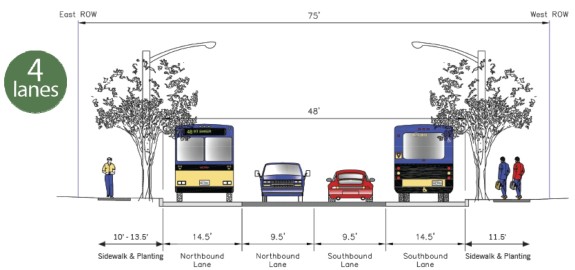
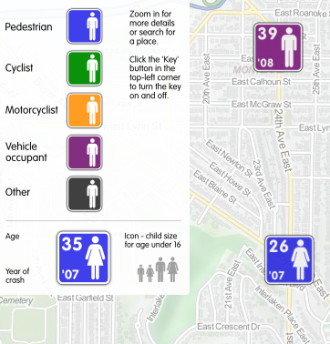
So if I understand correctly…. 23rd Ave through the CD becomes basically bumper to bumper, and traffic on MLK probably increases 50%? Why is that better?
It has been very frustrating at information sessions when I have asked about the impact of the 23rd Avenue redo on Martin Luther King. The question gets shrugged off with the answer that they do not anticipate any problems or particular increase in traffic on MLK. Are they kidding? After looking at the mess that is being made of Broadway and the effect it will have on 12th Avenue traffic, I have to wonder what these planners think they are improving.
There is not enough traffic on 23rd/24th to cause these issues. Adding a center turn lane improves traffic flow because turning cars don’t block travel lanes. The city has found that three-lane streets (one in each direction + a turn lane) can easily handle up to 25,000 vehicles per day before reaching any significant impact on capacity. 23rd south of Madison currently carries 17,500 per day. North of Madison, 23rd/24th carries 18,000.
This is not “shrugging off” your concerns about traffic moving to other streets, it’s data-based evidence that those concerns are not likely to happen.
I know it seems counter-intuitive that fewer lanes can carry the same traffic levels, but it’s the truth. The center turn lane is very efficient, and the three-lane design is way, way safer for everyone. Four lane streets don’t belong in neighborhoods, especially when the traffic levels can easily fit on a safer street design.
I thank the Universe that powers of reason are at least halting (for now) this devastating project at just the John/Rainer portion.Gridlock through our beautiful arboretum and MLK are not valid tradeoffs for a few bicycles that will use 19th anyway. Idling cars and speeding through quiet streets that are known side effects of other ‘calming’ efforts will be avoided through the north at least through this great news. We need to stop the aggressive and irreparable damage being waged against the current vehicle population and arterial streets. Ending the war on cars means taking action whenever we have the means. I’m in!
“Idling cars and speeding through quiet streets that are known side effects of other ‘calming’ efforts”
That’s not true. There are piles of studies from Seattle streets as busy as 23rd/24th that show side street traffic did not rise after main drags were made safer (see: Nickerson, Stone Way, NE 125th for examples).
However, one effect is certain: Fewer people (our neighbors, friends, co-workers, family members) will be injured and killed. Collisions will go down, and injury-causing collisions will plummet. This is an actually proven effect. That’s a goal worth working towards.
Complete streets are about everyone traveling by every mode. If you like speeding and making stressful left turns across two lanes of traffic, then yes, this redesign will not help you. But if you just want everyone to get where they’re going safely and more comfortably, then this is great chance to make those improvements.
Thanks for hitting home my original comment by pointing out Stone way (my regular commute). What once took 1 to 2 light cycles to clear out 45/50th intersections at rush now takes upwards of 6. No data points needed, I live the reality. Never ending single rows of cars sitting and spewing fumes into the homes that line the new ‘calming plan’ streets. With very few cyclists to be seen. Having better things to do, I don’t wait for 7 lights anymore, I head into the side streets with my furious motorist brethren. And mark this post – humans will get injured or killed by motorists speeding through calm residential side streets, bound to happen as the furor builds. Just like ant farms from childhood – if a route collapses, the ants will find a quick and more efficient way to deliver their agendas – Humans are no different. One other point – “Piles of studies by the city “don’t hold much for those that work in big data, anyone can spin and twist data points and stories to get their agenda across, which is exactly what the city is doing, and sadly the Complete Street agenda clearly believe in. Complete streets impedes traffic, penalizes the many and benefits the few in comparison. The gridlock in this city has become epidemic and will only get worse w/ initiatives like this.
You can cite all the studies you want claiming 2+turn will carry just as much as 2+2, but nobody who has ever driven either 23rd or MLK at busy times will ever believe you. Unfortunately, the changes proposed sound like they won’t be able to be undone if they turn out to be disastrous.
A lot of complaints about not being able to cross a street without taking your life into your hands could be cheaply and easily addressed. Build a couple of pedestrian-controlled buttons with lights embedded in the crosswalk between the major traffic-lighted intersections. (Just like over by Seattle U). I’ve never seen drivers disregard them and speed by anyway. And aren’t there plans to close the Arboretum access ramp to 520 anyway? That will mean 23rd/24th will get even worse anyway. A lot of those drivers forced onto 24th will stay on it to continue S through the CD. This whole plan sounds like a bad joke. Did SDOT recently hire people from Chris Christie’s administration?
That’s bull 122.
Many of us beleive in the 3 lane system. 23rd is terrible as a four lane. Too narrow for passing busses and right/left turners stopping every block. I can see going to 4 lanes to cross Madison or something, with a fifth for turns down the hill. Things like that to eliminate log jams at long lights is fine.
Nobody goes over to 24th unless there are protesters in the road. That’s dumb. 24th is too slow, too narrow, and has a higher probability of violence. The people speeding down 24th are the people who want to avoid cameras and police. They are criminals and they will choose the back streets every time. Most people on 24th street are problematic in some way.
3 lanes could work IF it weren’t for the fact that they aren’t building bus turn-outs in (If I’m reading this correctly). Are we supposed to try and pass in the turn lane now? This is going to suck.
This car-driving, bus-riding, non-bike-riding, often-on-foot CD resident is very much looking forward to the great improvements in Phases 1 and 2. I’m especially looking forward to the ability to reclaim my legal right to cross 23rd at the intersection near my house (Pine St), with traffic stopping to let me do so instead of speeding by me illegally. A right that I possess according to Seattle law, here and in the “unmarked crosswalk” at every other other intersection up and down 23rd. A right that drivers have long ago ceased to grant me, requiring me to walk an extra 1/4 mile or take my life into my hands.
RCW 46.04.160
Crosswalk.
“Crosswalk” means the portion of the roadway between the intersection area and a prolongation or connection of the farthest sidewalk line or in the event there are no sidewalks then between the intersection area and a line ten feet therefrom, except as modified by a marked crosswalk.
WAC 132E-16-040
Pedestrians — Right of way.
(1) Stopping for pedestrian. The operator of an approaching vehicle shall stop and remain stopped to allow a pedestrian to cross the roadway within a crosswalk unmarked or marked when the pedestrian is upon or within one lane of the half of the roadway upon which the vehicle is traveling or onto which it is turning.
What did you all expect, a fair and equal footing with the rest of the city for a real complete street? Are you kidding! The city see us as a continent zone of more than just crime and low income social service housing. They see us a a place not deserving of the same amenities that the rest of Seattle has. Give in to us and we will expect equal amenities all around. Dedicated bike lanes, in the CD???!!?? Move along, nothing to see here, just go to your meetings, vent and go home, your getting nothing,never did and never will.
Tom’s plan sounds like a good one, but I can see why it was posted to the seattlebikeblog rather than the CDNews. It’s basically a bike issue. That stretch of 24th is the only good option for speeding cyclists down to Montlake and the U district.
Based on some of the comments posted here, it doesn’t sound like we have a focused CD community ready to advocate. I’m a little surprised that readers continue to be so brain dead status quo when it comes to improving 23rd.
What do you mean? Eyes is focused. CONTAINMENT ZONE! CONTAINMENT ZONE! Always on-message.
There goes jim98122x the troll again. Glad it bothers you to see my posts, truth kinda gets under your thin skin? Expect more.
Doesn’t bother me, I just laugh along with everyone else. Seems like you’re the one who gets worked up about it. Keep it up, you’re great comic relief.
Jim’s negative bile is just a distraction. Ignore it.
I didn’t realize the name had changed to Central District Op-Ed. Certainly not reporting the CD news in an unbiased journalistic manner.
Keeping 23rd/24th as 4 lane main arterial is the right thing to do. Reducing it to 2 lanes at any point is a huge mistake. Its bad for businesses, bad for traffic mitigation, bad for transit.
Reality is – not every roadway is meant to be a sleepy little side street that accommodates every type of transit. Some roadways are meant to be exactly what 23rd/24th is. Will the next step be to put bike lanes and sidwalks on the freeways? “Oh – They drive so fast on those freeways – certainly we should slow them down to make it safer”
Four lanes, two in each direction, moves vehicles better and is less restrictive to traffic flow than two lanes and a center turn lane. Certainly, if you want safer streets and slower traffic – just create a roadway bottleneck like this is going to do (i.e. traffic jam so no one is moving). Problem solved.
I do pose one question – if a bike lane is added to 23rd/24th from Montlake to Madison, would you support uphill only, no downhill? I suspect not – but would like to hear you out.
Thanks for making us aware of this, Tom. I will contact SDOT immediately to demand that they do a thorough complete streets analysis of 23rd/24th north of Madison, and to recommend that a road diet be the preferred solution.
I live just off of 23rd at Republican and it’s a nightmare walking along and across 23rd. My kids and I often wait for the bus at on 23rd at Republican, and the way cars race by just a foot in front of us is terrifying. I also drive on 23rd all the time, but would be happy to sacrifice travel time in my car so that the pedestrian experience is safer and more comfortable. I used to live on Phinney Ridge, and Greenwood Ave, which was road dieted from 4 to 3 lanes years ago, is a fantastic example of how this treatment can work for all users — safe for peds and bikes while still moving traffic along just fine (just not at 40 mph). This is NOT a war on cars. It’s simply a movement towards a more balanced multimodal transportation network that works for everybody.
Your right Dave. I had forgotten th Phinney diet. I was living in Ballard a the time. It is much nicer now.
One thing that can work is to cut bus service by 75% and move the routes to MLK. It’s not to much to expect bus riders to walk a few blocks.